
Gesneriaceae, the gesneriad family, is a family of flowering plants consisting of about 152 genera and ca. 3,540 species in the tropics and subtropics of the Old World and the New World, with a very small number extending to temperate areas. Many species have colorful and showy flowers and are cultivated as ornamental plants.

Gloxinia is a genus containing three species of tropical rhizomatous herbs in the flowering plant family Gesneriaceae. The species are primarily found in the Andes of South America, but Gloxinia perennis is also found in Central America and the West Indies, where it has probably escaped from cultivation.

Columnea is a genus of ca. 200 species of epiphytic herbs and shrubs in the flowering plant family Gesneriaceae, native to tropical America and the Caribbean. The tubular or oddly shaped flowers are usually large and brightly colored – usually red, yellow, or orange – sometimes resembling a fish in shape. A common name is flying goldfish plants due to the unusual flower shape.

Kohleria is a New World genus of the flowering plant family Gesneriaceae. The plants are generally tropical herbs or subshrubs with velvety stems and foliage and brightly colored flowers with spots or markings in contrasting colors. They are rhizomatous and commonly include a period of dormancy in their growth cycle. The genus was revised in 1992 and was then recognized as having 19 species distributed in Central America and South America. phylogenetic in 2005 indicated that the epiphytic genus Capanea is derived from within Kohleria, and the two species of Capanea were subsequently transferred to Kohleria. The genus Pearcea is closely related.

Seemannia is a New World genus in the flowering plant family Gesneriaceae. There are four species in the genus, primarily found in the Andean regions of South America. The name honors the German botanist Berthold Carl Seemann.
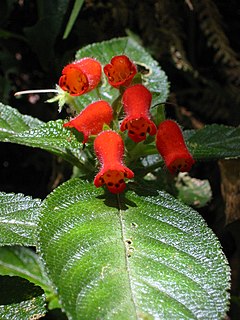
Pearcea is a South American genus of 17 species of tropical herbs in the flowering plant family Gesneriaceae. It is classified in tribe Gloxinieae and is closely related to the genus Kohleria, in which some of its species were previously included. The genus Parakohleria has recently been synonymized under Pearcea, a conclusion later supported by molecular analyses that showed that Pearcea hypocyrtiflora was nested within the former Parakohlerias.
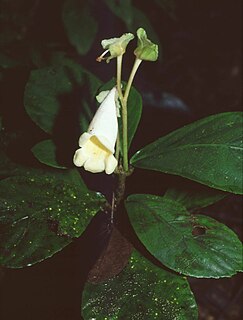
Gasteranthus is a genus of 35 species of herbs and soft-stemmed subshrubs in the flowering plant family Gesneriaceae. The species occur in Central America and South America, from southernmost Mexico to Bolivia. Numerous species are threatened with extinction, mainly due to deforestation. This is due to two reasons: For one thing, Gasteranthus species are native to countries in which destruction of primary forest runs rampant; also, these plants do not distribute well and therefore endemism is very frequent, for example on isolated mountain ranges.

Nematanthus is a genus of flowering plants in the family Gesneriaceae. All of its species are endemic to Brazil. Compared to other gesneriads, Nematanthus has leaves that are small, succulent, and hard-surfaced. The plant has a trailing, branching, and spreading habit; it is generally an epiphyte in nature and a hanging-basket plant in cultivation. The flower has fused petals. In some species, the flower has a "pouch" at the bottom. The fancied resemblance of such flowers to a goldfish gives these plants the common name goldfish plant or guppy plant.
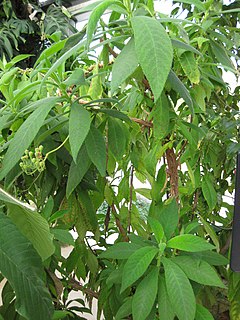
Alloplectus is a genus of Neotropical plants in the flowering plant family Gesneriaceae. A recent revision of the genus includes five species, with the majority of species in the genus as traditionally circumscribed being transferred to Crantzia, Glossoloma, and Drymonia.

Nautilocalyx is a genus of plants in the family Gesneriaceae. Its native range stretches from Costa Rica to southern Tropical America and to Trinidad. It is also found in Bolivia, Brazil, Colombia, Costa Rica, Ecuador, French Guiana, Guyana, Panamá, Peru, Suriname, Trinidad-Tobago and Venezuela.

Reldia is a genus of plants in the family Gesneriaceae. They are also in the Beslerieae tribe.

Koellensteinia is a genus of flowering plants from the orchid family, Orchidaceae. It is named by Heinrich Gustav Reichenbach for the Captain Carl Kellner von Koellenstein, an Austrian military officer and a botanical correspondent of Reichenbach.
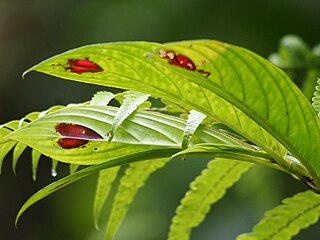
Columnea consanguinea is a species of flowering plants in the genus Columnea. They are endemic to Colombia, Costa Rica, Ecuador, Nicaragua, and Panama. They are distinctive for possessing red translucent heart-shaped markings on their leaves that serve to attract their main pollinators - the hummingbird Heliodoxa jacula - to their more inconspicuous flowers.
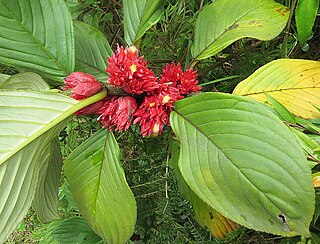
Glossoloma is a genus of Neotropical plants in the flowering plant family Gesneriaceae. The species in the genus were formerly placed in Alloplectus. They are subshrubs with the leaves clustered at the ends of branches, and tubular flowers.
Amalophyllon is a genus of flowering plants belonging to the family Gesneriaceae.

Codonanthopsis is a genus of flowering plants in the family Gesneriaceae. Its native range is from southern Mexico through tropical America to Bolivia and most of Brazil. Codonanthopsis species are generally trailing epiphytes with pale flowers. Most have a mutualistic relationship with tree-living ants: the plants provide the ants with food, including nectar, and give their nests structure and support, while the ants disperse the plants' seeds. The genus was considerably expanded in 2013 when species were transferred from Codonanthe. Some Codonanthopsis species are cultivated as houseplants, when they may be grown in hanging baskets.
Cobananthus is a genus of flowering plants in the family Gesneriaceae, with a single species Cobananthus calochlamys. It is sometimes included in the genus Alloplectus, but molecular phylogenetic studies suggest that the two genera are not closely related, with Cobananthus more closely related to Alsobia.
Rufodorsia is a genus of epiphytic flowering plants in the family Gesneriaceae. The genus name refers to the reddish back of the upper lobes of the flower. The relationship of Rufodorsia with the genus Oerstedina is uncertain, as of April 2021. It is native to montane cloud forest in Central America.
Oerstedina is a genus of epiphytic flowering plants in the family Gesneriaceae, native to Mexico, Costa Rica and Panama. The relationship of Oerstedina to the genus Rufodorsia is uncertain, as of April 2021.
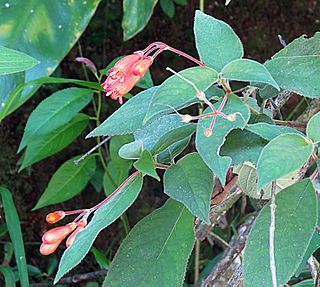
Moussonia is a genus of plants in the family Gesneriaceae. Its native range stretches from Mexico to Central America. It is found in Costa Rica, El Salvador, Guatemala, Honduras, Mexico and Panamá.
















